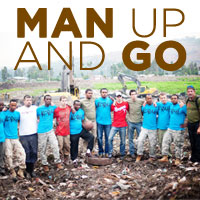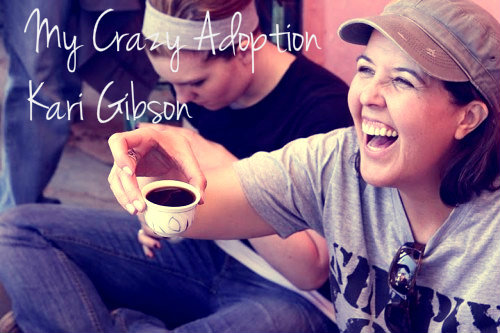Archive | Adoption [VLOG]
Tags: Adoption, adoption advice, boundries
Adoption 101: Setting Crazy Boundries
Posted on 16 July 2010 by Kari Gibson

Tags: Adoption, Featured, Gary Chapman, love languages, Orphan Care
My Crazy Love Language
Posted on 14 July 2010 by Kari Gibson
Roger and I both have our own unique adoption love languages. We wanted to share our craziness with you. I want to know what YOUR crazy adoption love language is (will you share?)
Tags: adoption advice, adoption blog, adoption support, orphan care
Adoption 101: Owies in the Heart Part 2
Posted on 12 July 2010 by Kari Gibson

Tags: Adoption, adoption blog, ethiopia adoption, gotcha day, Orphan Care
Happy Gotcha Day Princess Zoie
Posted on 07 July 2010 by Kari Gibson
Zoie, we are amazed that you have been a part of our family for two years today!!! You are our princess and have been our dream come true. Your sparkle and zip for life keeps us all hopping and grateful for God’s gift of high energy. We are crazy in love with you from head to toe.
We love you, from mommy and daddy…
Our Gotcha Day Video 2008

Tags: Adoption, adoption advice, Featured, Orphan Care, parent advice, support
Owies in the Heart Part 1
Posted on 06 July 2010 by Kari Gibson
Owies in the Heart Part 1
Tags: Adoption, adoption advice, adoption support, parent advice
Adoption 101: Marriage and Adoption Mini-Series
Posted on 05 July 2010 by Kari Gibson
Roger and I love sharing adoption advice to help support and encourage you on your adoption adventure. We are not professionals, just two crazy parents who love being a mom and dad. We had so much fun going to a little studio with our Flip and making the adoption series just for you! The next two weeks, please take the time to watch our short videos and leave any additional advice to share with readers. Your interaction is valuable and helps to make our Adoption Life LIVE a collaboration of many adoption families!! We are all in this together. I want to hear what you are thinking… [enjoy!!]
Tags: Adoption, adoption blog, Adoption training, attachment, attachment problems, bonding, Ethiopia adoption blog, Featured
Crazy Adoption 101: 4 Keys to Healthy Attachment
Posted on 01 December 2009 by Kari Gibson
Answers to Tuesday Trivia #1 – What is attachment and why is it so important?
Simple definition: Attachment is a relationship.
My story: July 7, 2008, Zoie was so sick when we first met her that she immediately attached to us for survival. All her needs were being taken care of and by the time we left Ethiopia, she was thriving. We are a very affectionate family and Zoie fit right in with hugs, kisses and joy. The only thing missing for me was the special time I remember having when I fed and rocked my babies at night. It’s an intense bonding experience. From the beginning, Zoie would allow me hold her, rock her, and feed her, but there was something missing. I would hold her tight to me and she would slightly push me away. She would respond to me, cry for me and allow me to soothe her, but I knew I needed to keep working on our special bond. I will never forget the night when we linked hearts… daughter and mommy. I did my regular routine and fed Zoie her bottle and rocked and sang to her. All of a sudden, she looked in my eyes and wrapped her arms tightly around me. Her tiny arm went behind my back and she snuggled her head on my heart. One year after adopting my sweet girl, I felt an intense bonding. Now, every nap and night time I tuck her in bed, we have our special snuggle time.
“Bonding and attachment are two terms used to describe the process of an adopted child feeling secure in her new family. Often used interchangeably, the concepts are actually differentiated by adoption experts.”
4 Keys to Healthy Attachment: Why is it important?
- Parent equals satisfaction.
- The world is a good place.
- You can trust people to meet your needs
- Your needs make sense.
The attachment cycle has been called the Season of the Soul. Children who miss this cycle seem to others to be robotic or just plain angry. They have a desperate sadness. A boy from an orphanage explained, “I feel like I’ll get lost in my sad. I think that I am going to die when I get sad.”
According to Deborah Gray, author of Attaching in Adoption, attachment is a relationship formed primarily with members of the family and requires more time and interaction to be created. Attachment is what most adoptive parents are referring to when they talk about bonding with their child. Adopted children of all ages may have an attachment to their birth family, even if the relationship was neglectful or abusive. Many adoption experts agree that if a child can form an attachment to birth and foster parents, she will have the skills to attach to her adoptive family as well.
The Attachment Cycle
Gray outlines in her book the attachment cycle that needs to occur in order for children to form positive attachments with their caregivers.
When a child is distressed, she may show signs such as increased pulse, increased respiration, helplessness, hopelessness and enrage. When the adoptive parents enter the situation with food, physical contact and other help, the child learns her parents can meet her needs. The child is then more active and able to respond to stimulation such as playing. When the child is content, she is able to sleep and feel comfortable in her surroundings.
Attachment versus Bonding
As described in Raising Adopted Children, bonding is a “process that begins with the biological parent during pregnancy and continues through birth and the first few days of life.” This definition shows why an adopted child can feel a bond to her birth mother, but possibly not feel any attachment to her. Bond can also describe the close relationship kids have with teachers and friends with which they have shared important experiences and emotions.
Signs of Secure Attachment
The attachment process can take weeks or years to develop, and in some cases there maybe attachment disorders for which therapy will be required. A good indicator of whether attachment is taking place is the comfort with which the adoptive parents can recognize the child’s needs.
Melina writes in Raising Adopted Children, “Another sign of secure attachment is the child’s willingness to move away from the parent, returning to his parent during times of stress to regain the confidence he needs to be on his own again.” The parent’s ability to let the child go and explore is also an indication of secure attachment.
Attachment is a never-ending process that begins with the arrival of the child and will continue to strengthen throughout the child’s life. Valuable resources are available on-line including discussion boards for attachment issues in adoption and information for fostering attachment with children adopted internationally.”
Related Articles:
Attaching to Adopted Infants and Toddlers
Attaching to Adopted School Age Kids
Attaching to Adopted Preteens and Teens
Please leave your own stories on attaching, issues or problems so we can all learn together.

Tags: Adoption, adoption blog, Christmas memories, Christmas tree, Ethiopia adoption blog, Family Fun, Videos
Adoption Life LIVE – Make a Christmas Memory Tree
Posted on 29 November 2009 by Kari Gibson
Tags: Adoption, adoption advice, adoption blog, ethiopia adoption, Ethiopia adoption blog, Orphan Care, Videos
Kari talks LIVE… I need your help with hot topics!
Posted on 17 November 2009 by Kari Gibson
Watch my first Adoption Life LIVE video! It’s time for me to talk to you, my readers about adoption from A to Z. I don’t have a fancy studio or the best equipment, it’s just me and you and my Flip talking candidly about our favorite subject! Hopefully, my awesome hubby will join me sometimes to give a daddy’s perspective on the subject of adoption. I have watched his life change radically through the miracle of adoption. We welcome you to leave us any questions, comments or subject ideas you would like to talk about.. email me. As I have shared, I want to give back honest, real answers from my life as I continue to grow as a wife, mom and friend.
I want My Crazy Adoption to educate you, inspire you, make you laugh, offer hope, and eliminate any fears you might have about adoption. Bloggy readers, I wasted YEARS wrapped in fear, worry and uncertainty about adoption and if I can save just one person from holding back on the most incredible, life-changing adventure… it’s all worth it!
I would love your feedback. Do you have any specific questions or hot topics you would like me to discuss LIVE?

Tags: Adoption, adoption blog, ethiopia adoption, Ethiopia adoption blog, Orphan Care
Crazy Adoption 101: What the heck is a I-600A?
Posted on 10 November 2009 by Kari Gibson
Warning: You will become a mailman stalker waiting for your I-600A form to arrive from USCIS. It’s the luck of the draw on the timing of these little buggers. The poor mailman has nothing to do with how fast or slow it is delivered to your mailbox! You will need to contain yourself when you hear the familiar sounds of the truck approaching your home. We don’t want you to earn the reputation of crazy mail chasing mom-to-be. Personally, I was like a tail wagging, foaming at the mouth, crazed eyed puppy, waiting at the door for my I-600A to come. It wasn’t pretty.
When you receive your I-600A in the mail…. celebrate! This really is a big deal. For us, it meant our dossier was complete and the wait for Zoie was really on. I will never forget the day it finally came in the mail, 3.5 months after submitting our forms to MO USCIS. I was so overjoyed, I called Roger and told him we were going out to party hard with burgers and shakes! I announced to the waitress and humiliated my kids simultaneously, that I was now officially pregnant and due hopefully in less than 12 months.
I received this hilarious letter from an adoption newbie… I-600A form. What the heck? I still don’t think I have an understanding for when I am supposed to send this thing in or when we get our fingerprints, etc. It might be helpful to step us through that. I do know that there are new mailing instructions as of 10/09 – once we have our I-600A and whatever documents go with it, it gets mailed to a ‘central lock-box’ in TX. Then at some point we’ll get a receipt that it was received, and once processed I think we get a fingerprint card. I don’t know about fingerprint appts or anything like that. (Thanks Jamey!)


Tags: Adoption, adoption blog, ethiopia adoption, Ethiopia adoption blog, Featured, Orphan Care
Crazy Adoption 101 + Dossier Baby Binder
Posted on 05 November 2009 by Kari Gibson
I’ve created Adoption 101 for the beginners. We all had to start the adoption process the same way, constructing piece by piece a Home Study & Dossier. You’ve heard the term Pregnancy Paper Trail or Dossier Baby, due to the vital importance of its growth and birth pattern. Your dossier will be one big fat baby! You don’t want to lose your Dossier Baby, so the best place to keep it safe is in one big binder. Have fun, you can decorate your binder from top to bottom in pinks, blues or crazy colors, but the inside.. the guts of the dossier are priceless. My friend, Jamie actually lent me her dossier and I remember her telling me if there was a fire, grab your kids and my dossier and then run for your life! Jamie held my hand through the entire paper pregnancy, so I dedicate this post to her! Thanks Jamie for putting up with all my craziness.
What is an adoption dossier?
Dossier: When used in the context of adoption, this term refers to a set of appropriately authenticated and translated legal documents which are used in international adoption cases to process the adoption of a child in its own country by the adoptive parents, or for the adoptive parents to obtain the legal custody or guardianship of the child in the foreign court, so the child can be brought by the adoptive parents to the United States for adoption.
Constructing your Home Study & Dossier Paper Baby:
Important Tip:One of the most difficult parts of putting together an adoption dossier can be finding a notary to notarize your documents. It may be worth the effort to have a friend become a notary or to find an individual you can pay to accompany you to doctor’s offices, employers and other locations.
Craziness:
There are courier services available (check with your agency) that will assist you and dossier preparation services to construct your documents for home study and dossier. If you are overwhelmed with paperwork, this service might be the answer for you.
Check out this link: The Adoption Stork
If you start feeling craZy, email me and I promise I’ll cheer you on! You can do it! Let me know in comments what newbies want in Crazy Adoption 101.
Operation: Nicaragua

-
CATEGORIES
- Adoption (179)
- Adoption [VLOG] (11)
- Featured (11)
- Giveaway (2)
- Inner Beauty (8)
- Man Up (1)
- Missions (180)
- Mommyhood (106)
- My Crazy Blog (144)
- My Crazy Stuff (320)
- My Life Is Crazy Too (50)
- Orphan Care (86)
- Top Adoption Grants (1)
- Wednesday WOW Recipes (52)
-
ARCHIVES
- March 2013 (5)
- February 2013 (14)
- January 2013 (3)
- December 2012 (12)
- November 2012 (6)
- October 2012 (9)
- September 2012 (1)
- August 2012 (3)
- July 2012 (8)
- June 2012 (11)
- May 2012 (3)
- April 2012 (8)
- March 2012 (22)
- February 2012 (7)
- January 2012 (14)
- December 2011 (14)
- November 2011 (19)
- October 2011 (15)
- September 2011 (21)
- August 2011 (17)
- July 2011 (17)
- June 2011 (25)
- May 2011 (17)
- April 2011 (19)
- March 2011 (21)
- February 2011 (22)
- January 2011 (27)
- December 2010 (22)
- November 2010 (23)
- October 2010 (21)
- September 2010 (21)
- August 2010 (15)
- July 2010 (25)
- June 2010 (21)
- May 2010 (18)
- April 2010 (23)
- March 2010 (25)
- February 2010 (21)
- January 2010 (29)
- December 2009 (28)
- November 2009 (35)
- October 2009 (31)
- September 2009 (18)
- August 2009 (26)
- July 2009 (49)
- June 2009 (44)
- May 2009 (37)
- April 2009 (30)
- March 2009 (14)
- February 2009 (11)
- January 2009 (16)
- December 2008 (7)
- November 2008 (13)
- August 2008 (1)
- January 2008 (1)


















